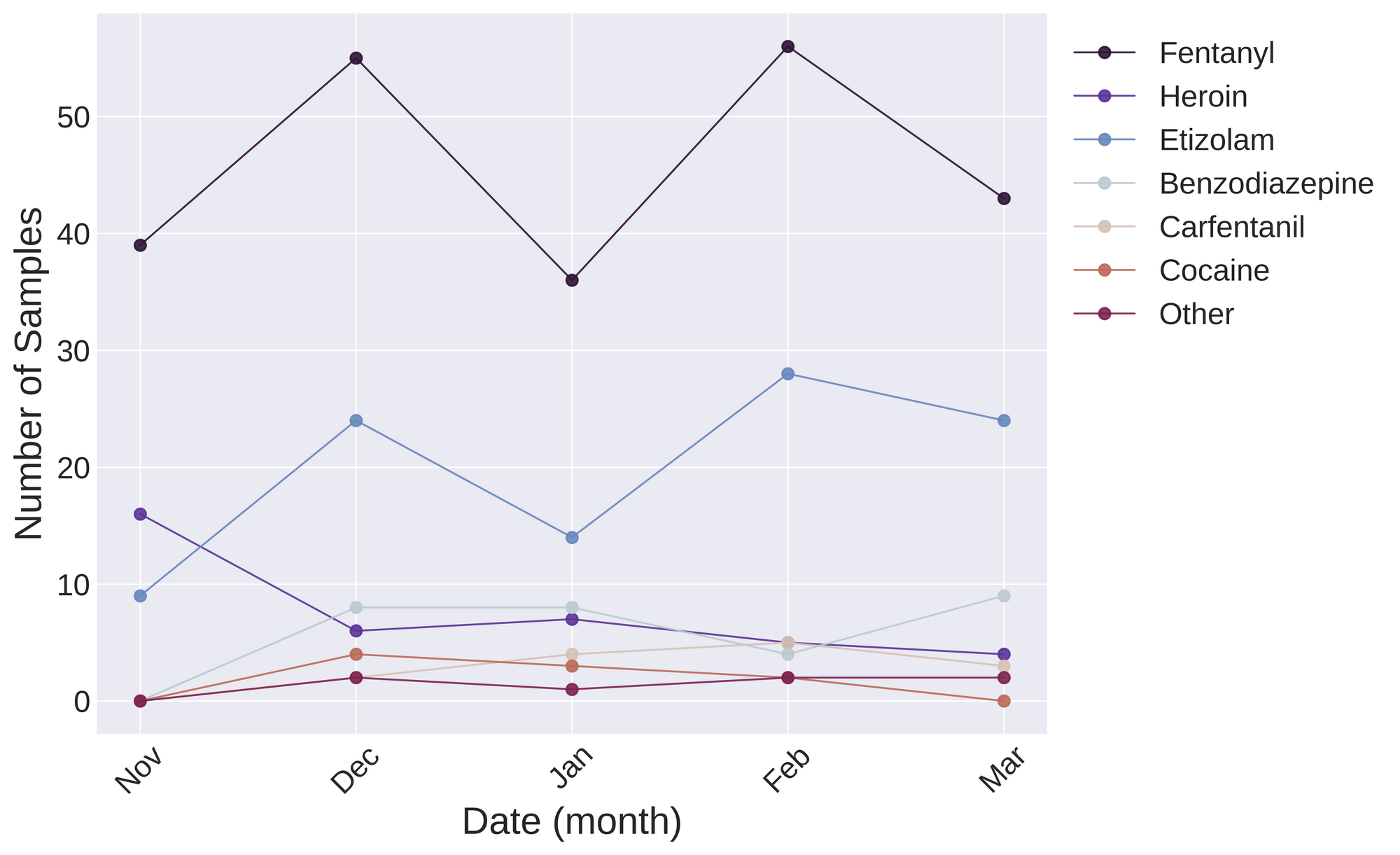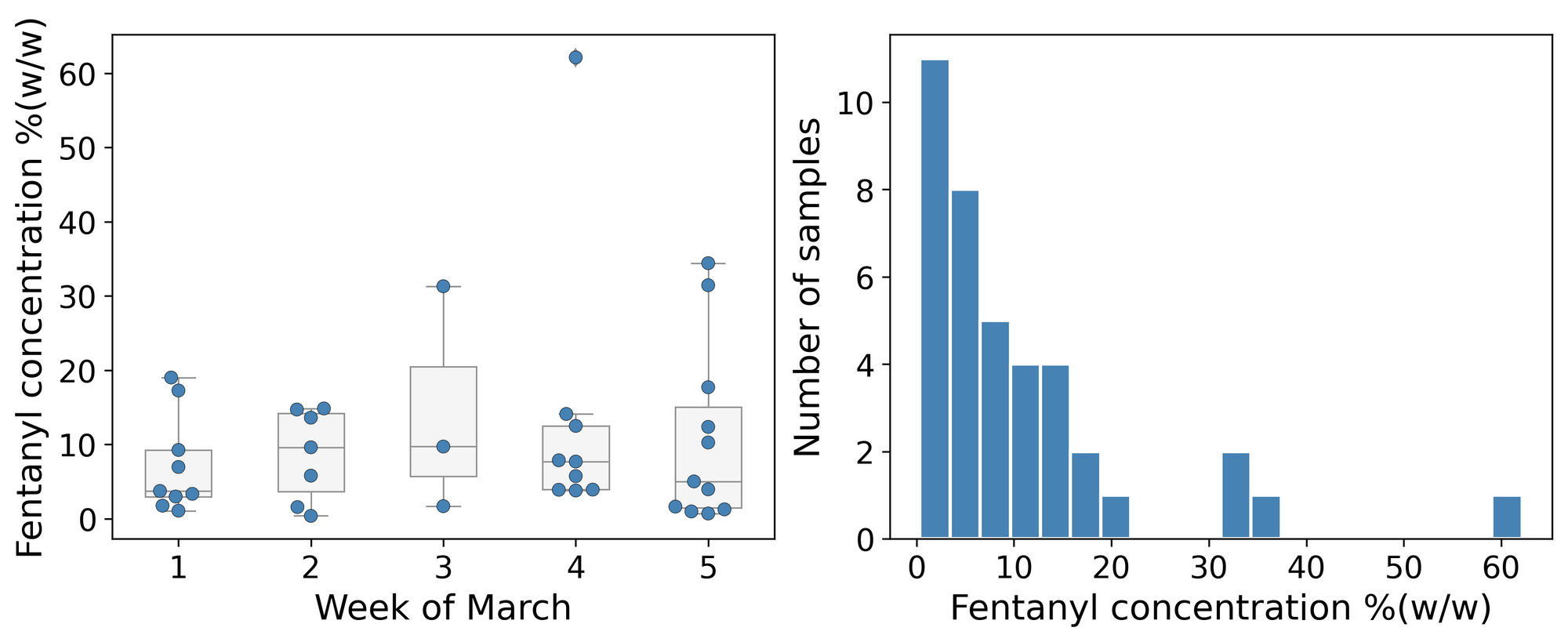March 2021 Monthly Report

In this blog post we discuss our March 2021 report and provide more information on how to interpret the results. The PDF report can be found at the end. We would also like to announce that this month we moved to our new store-front location!
Key findings:
- Carfentanil found in four samples, three were expected opioid-down and one was expected cocaine
- Two expected cocaine samples found to contain fentanyl with no cocaine
- 93% of expected opioid-down samples contained fentanyl
- Median fentanyl concentration of 7.0%, with a maximum concentration of 62.1% found in an expected opioid-down sample
- Median etizolam concentration of 2.0%, with a maximum concentration of 18.5% found in an expected opioid-down sample
- Benzodiazepines and/or etizolam found in 59% of expected opioid-down samples, an ~20% increase from the last two months.
Insight for the March 2021 Monthly Report
March has kept our team busy with the move to our new location and still checking 155 samples! We saw a 288% increase in service uptake from 2020.

Uncut drugs?!?
Hells yes they do exist! For many drug types, we often find over half of the drugs to be uncut. When we say uncut, we mean that through our various technologies we only find the expected drug.
Methamphetamine - 12/12 samples (100%) were found to only contain methamphetamine.
Ketamine - 6/6 samples (100%) were found to only contain ketamine.
MDMA - 10/11 samples (91%) were found to only contain MDMA. One sample instead contained MDA, which is a closely related compound.
Expected Cocaine HCl or Base (Crack) (n=27)
This month, 78% of cocaine samples were found to only contain cocaine with nothing else present in the sample. Four samples contained cocaine as the only active, but had additional cuts present of either creatine (2), glutamine (1), or procaine (1). Creatine is an exercise supplement, glutamine is an amino acid and procaine is a topical anesthetic related to cocaine.
Two cocaine samples were found to resemble opioid-down samples in their composition; neither contained any cocaine. One sample was found to contain fentanyl, and one sample was found to contain fentanyl, carfentanil, and a benzodiazepine. This highlights the critical importance of both substance users and dealers to accurately label their substances so baggies or containers don't get mixed up. If an opioid-naive person (i.e. someone who doesn't use opioid-down) was expecting to use cocaine but instead used one of the two samples above, it could result in a fatal overdose. We have heard stories of this scenario happening! Stay safe, and keep your substances organized.
Expected Opioid-Down (n=46)
In this section we present statistics specific to the opioid-down supply, therefore they may differ from the highlighted findings above that are inclusive of all expected drug categories.
Fentanyl and Analogues
- 93% expected opioid-down samples contained fentanyl (43/46)
- 6.5% samples contained carfentanil (3/46)
- 36% samples contained over 10% fentanyl (14/39 quantified)
Benzos and Etizolam
- 59% samples contained a benzo and/or etizolam (27/46)
- 52% samples contained etizolam (22/46)
- 20% samples contained a benzodiazepine (9/46)
This March, 63% of opioid-down samples contained an active in addition to fentanyl and/or heroin. This number has remained consistently high over the past few months: Jan (55%), Feb (55%), Dec (61%), Nov (20%). Fig. 1 shows the prevalence of actives being found in opioid-down samples over a five month time period.

Quantification for Expected Opioid-Down
These values differ from those contained in the attached PDF report because they are restricted to expected opioid-down samples.

In March, we quantified fentanyl for 39 of the 43 of the expected opioid-down samples that contained fentanyl. We found the median concentration to be 7.0% fentanyl. Fig. 2 demonstrates the spread of fentanyl concentrations in March by week (left) and for the month overall (right).
The average strength of fentanyl in opioid-down that we see during service is around 10% in general. The median concentration of 7.0% fentanyl for March is just below this average strength. Our findings illustrate the volatility of fentanyl concentrations in the opioid-supply, as any one sample in the week might be the lowest strength sample (0.4%) or the strongest sample (62.1%). This variability in concentrations, along with the high presence of etizolam and benzodiazepines, aligns with the tragic records being made for overdose deaths in BC as we continue to experience over 100 deaths per month. Read more here.

Unknown/Missing (n=12)
You may be wondering what it means when a sample is unknown or missing. If you’ve been to our service, you’ll know we ask a few questions when you drop off a sample. One of these questions is: “What is the drug expected to be?” If a sample is dropped off without any information about it, or if the service user decides to skip answering any questions, it is categorized as missing.
Sometimes a sample is brought in by a third party that didn’t know what the sample was. Sometimes a sample is found on the ground. Sometimes you come across a loose tablet in your pocket and you forget what it was. In all these cases, a sample would be considered unknown.
Something to think about:
If the expected drug was known, the sample would fit into the other main categories we report on and could change our data.
For example, 7 of the 12 unknown/missing samples resemble opioid-down. All seven contained fentanyl, five contained etizolam, and five contained a benzo. If we could include them into the opioid-down category, then the percent of opioid-down samples containing etizolam and/or a benzodiazepine would increase from 59% to 62%. For this reason, we continue to urge caution when interpreting our results.
Want to be notified when we release these reports? Join our mailing list to receive updates about when our reports are out. You can subscribe and unsubscribe yourself from this list at any time.
Check back next month for the April report!
As always, send us feedback at substance@uvic.ca for how we can continue to offer our drug checking results in a useful way.
